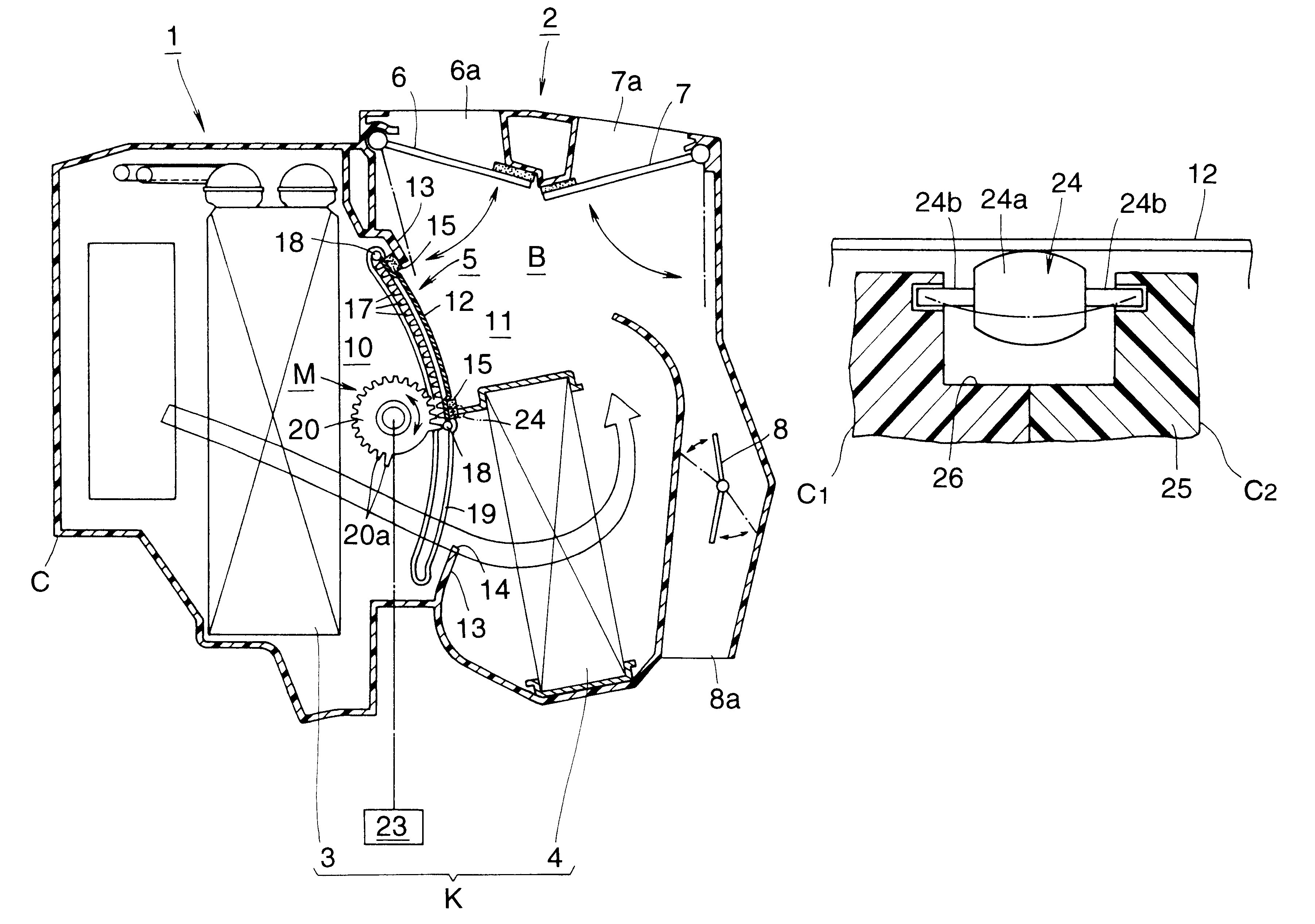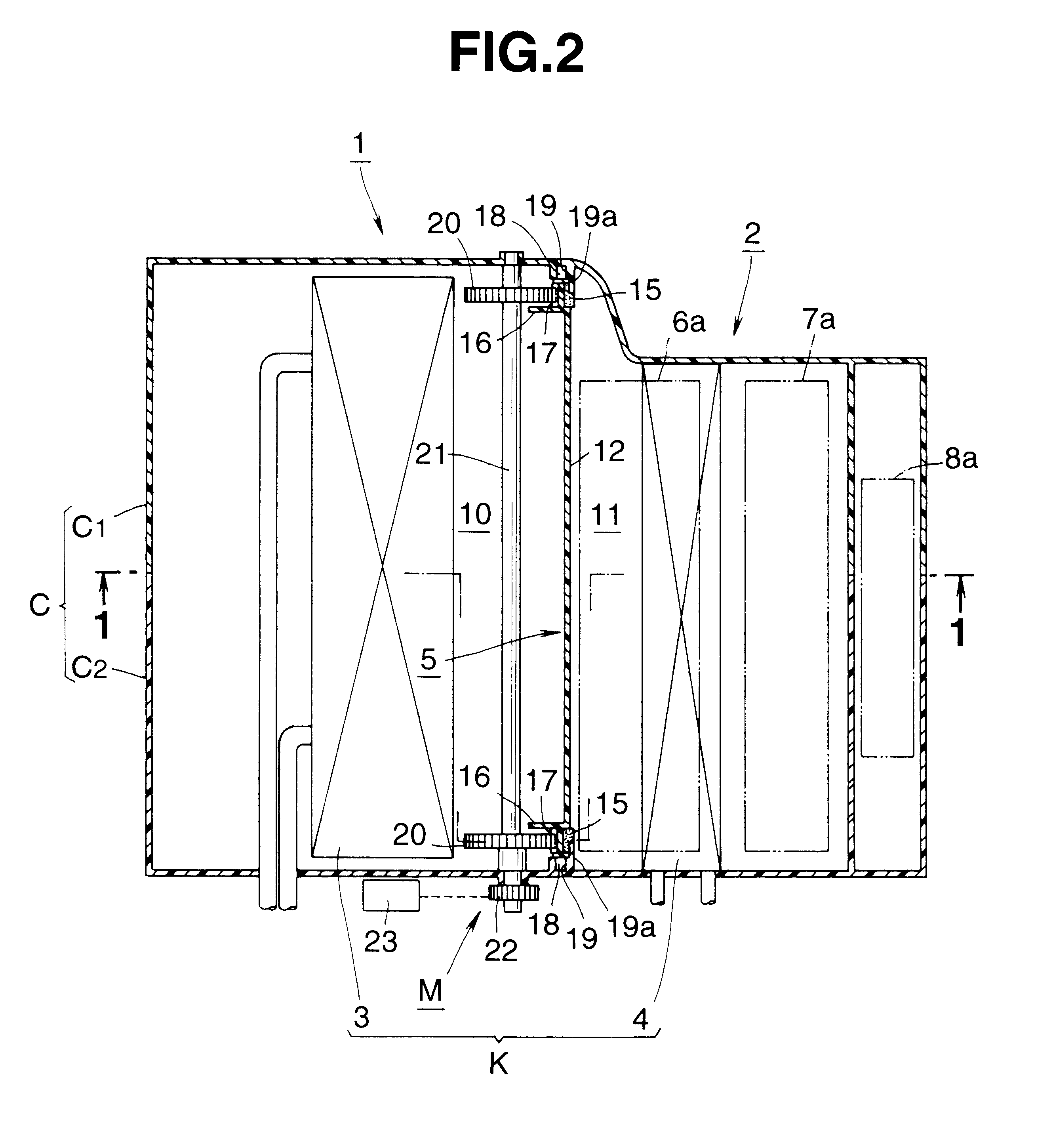Door mechanism of automobile air conditioner
a technology of automobile air conditioner and door mechanism, which is applied in the direction of machine operation, vehicle cleaning, lighting and heating apparatus, etc., can solve the problems of complicated and high-cost construction, further limited small vehicle cabin space, and difficult control of the distribution of cooled air and warmed air
- Summary
- Abstract
- Description
- Claims
- Application Information
AI Technical Summary
Problems solved by technology
Method used
Image
Examples
embodiment-1
[Embodiment-1]
FIG. 1 is a drawing showing an automotive air conditioning device which is an embodiment of the present invention, which is a sectional view taken along the line 1--1 of FIG. 2. FIG. 2 is a plan view of FIG. 1, FIG. 3 is a horizontally sectional view of a door mechanism, FIG. 4 is a partially cut perspective view of a door, FIG. 5 is an end view taken along the line 5--5 of FIG. 3, FIG. 6 is an enlarged illustration showing an essential portion of the door, FIG. 7 is an illustration showing a cam groove portion, and FIG. 8 is an illustration of a supporting roller, which is a sectional view taken along the line 8--8 of FIG. 7.
As is shown in FIG. 1, a door mechanism of an automotive air conditioning device of the embodiment is applied to a mix door.
As is shown in FIG. 1, the automotive air conditioning device is equipped with a case C which comprises a cooler unit 1 and a heater unit 2 which are united in such a manner as to reduce a longitudinal length "L" (see FIG. 16...
first embodiment
In this full-cool mode, a much amount of cooled air is forced to impinge against the door proper 12, which causes such a tendency that the door proper 12, which has a relatively long width, becomes deformed or flexed in a downstream direction. However, since, in this first embodiment, the laterally middle portion of the door proper 12 is resiliently supported by the supporting roller 24, undesired deformation of the door proper 12 is prevented even when a marked wind pressure is applied to the door proper 12. Furthermore, due to the same reason, smoothed operation of the door is achieved without suffering from undesired gear slippage, and lowering in the temperature controlling performance, which would be caused by the deformation of the door proper 12, does not occur. Furthermore, even if the door proper 12 is somewhat deformed under the influence of heat produced by the evaporator 3 and the heater core 4 which are positioned near the door proper, the deformation of the door proper...
embodiment-2
[Embodiment-2]
The automotive air conditioning device of this embodiment comprises, as is seen from FIG. 10, a unit case "C" which has a short longitudinal length "L" and includes a cooler unit 1 and a heater unit 2 which are united and aligned in a fore-and-aft direction of the associated motor vehicle.
Within the unit case C, there are installed an evaporator 3 which produces a cooled air by cooling air introduced thereto, a heater core 4 which produces a warmed air by heating the cooled air, a mixing chamber 31 which mixes the cooled air and the warmed air to produce a temperature-controlled air, a hoot duct 8d which is defined by both the mixing chamber 31 and a swelled inside wall 30, a defroster opening 6a and a ventilation-foot opening 40 which are arranged at an extension line of the inside wall 30, and a door mechanism which functions to control the cooled air and warmed air.
The door mechanism comprises a slide type mix door 5 which is arranged between the evaporator 3 and th...
PUM
 Login to View More
Login to View More Abstract
Description
Claims
Application Information
 Login to View More
Login to View More - R&D
- Intellectual Property
- Life Sciences
- Materials
- Tech Scout
- Unparalleled Data Quality
- Higher Quality Content
- 60% Fewer Hallucinations
Browse by: Latest US Patents, China's latest patents, Technical Efficacy Thesaurus, Application Domain, Technology Topic, Popular Technical Reports.
© 2025 PatSnap. All rights reserved.Legal|Privacy policy|Modern Slavery Act Transparency Statement|Sitemap|About US| Contact US: help@patsnap.com



